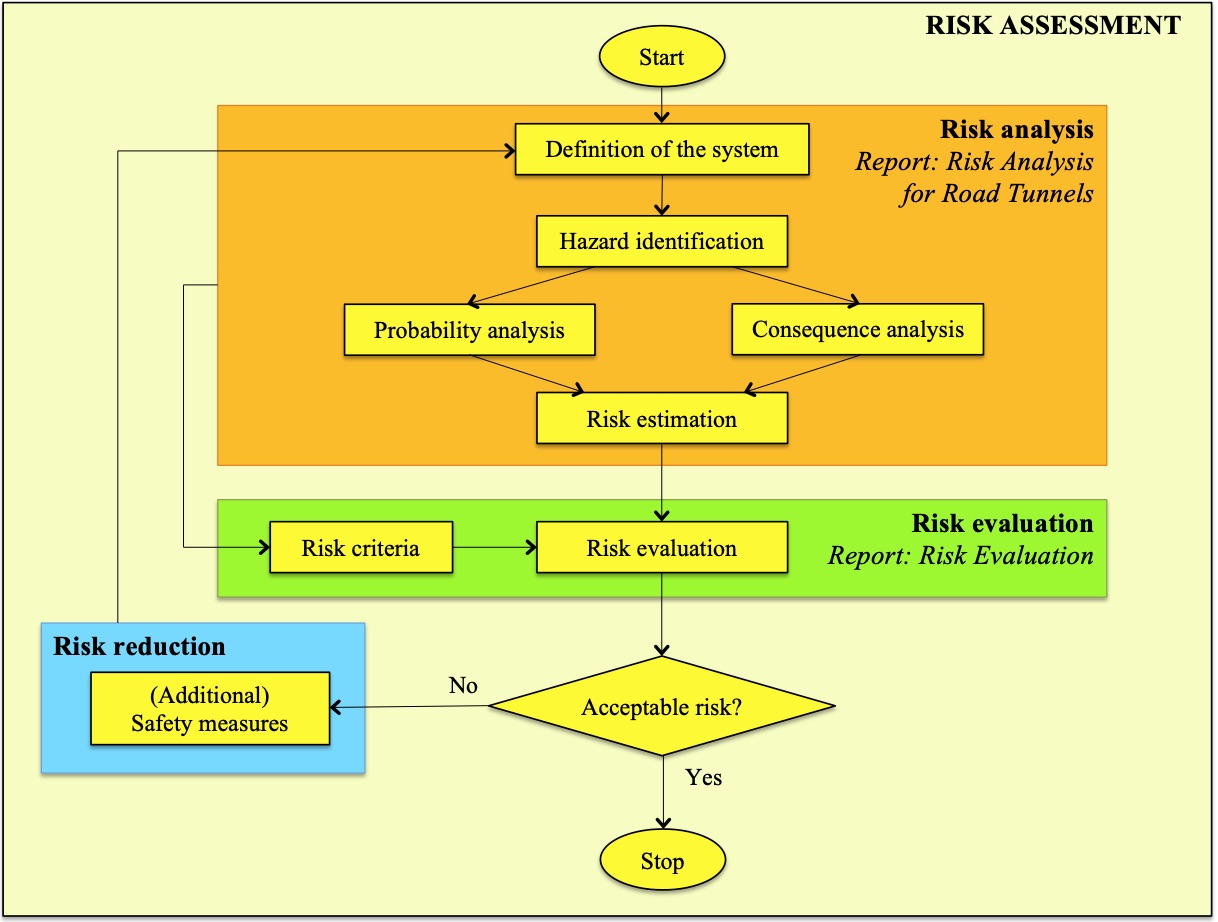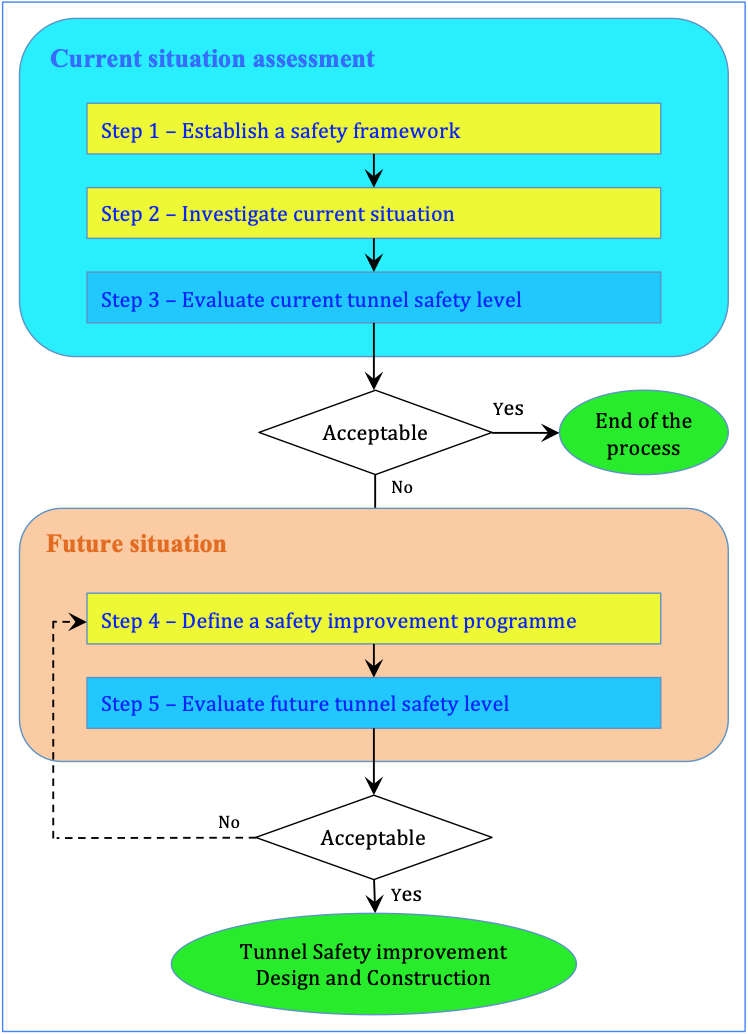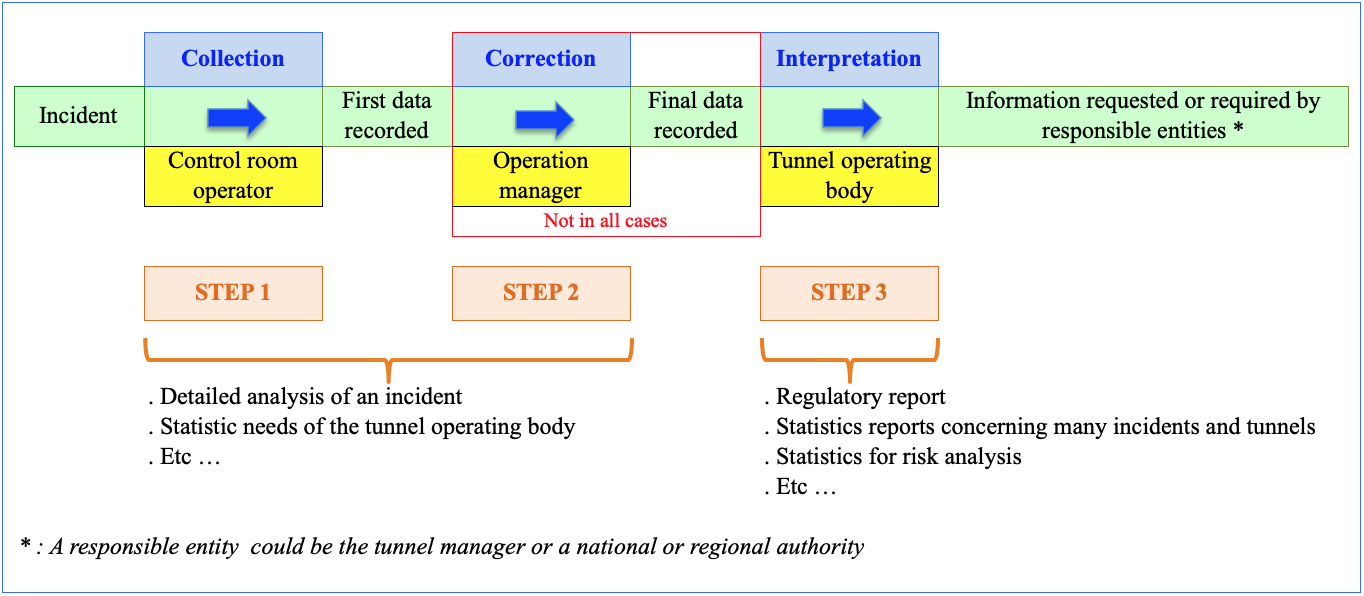

In the recent years various tools have been elaborated which are intended to give the stakeholders involved a common view and understanding how the safety features of a tunnel are interacting and how the tunnel interacts with its surroundings and the environment. They should also help to efficiently organise the decisions and actions required in order to ensure an adequate and constant safety level throughout the lifetime of a tunnel. These tools shall be able to summarize the current safety status of a tunnel in order to support management decisions regarding tunnel safety.
The safety documentation shall be an up-to-date safety record of a tunnel, providing a proper overview of all safety-relevant aspects and their current status. Risk assessment can be used for an in-depth analysis and quantification of these aspects, thus also providing quantitative information on the effectiveness of specific risk mitigation measures for an individual tunnel. Risk assessment tools are therefore often used to support decision making regarding the requirement of additional safety measures as well as for the selection of the best suitable combination of measures, which is in particular relevant for improving safety of existing tunnels. For hazards caused by a release of dangerous goods specific risk models are available.
Information on the current status of the safety systems of a tunnel is gained by regular tunnel inspections whereas learning from practical experience can be assured by a systematic collection and evaluation of real incident data. Regular emergency exercises and training of emergency services improves the preparedness for incidents which can never be completed excluded by preventive measures.
In addition to the traditional prescriptive approach, a risk-based approach - called risk assessment - can be used to address the specific safety features of a tunnel system (including vehicles, users, operation, safety systems, infrastructure conditions, and emergency response) and their impact on safety.
Various types of risk can be addressed in a risk based approach, such as harm to a specific group of people (societal risk), or to an individual person (individual risk), loss of property, damage to the environment or to immaterial values. Commonly, risk analyses for road tunnels focus on the societal risk of tunnel users which can be expressed as the expected number of fatalities per year or as a curve in the FN diagram showing the relationship between frequency and consequences (in terms of number of fatalities) of possible tunnel incidents.
Risk assessment is a systematic approach to analyse sequences and interrelations in potential incidents, thereby identifying weak points in the system and recognising possible improvement measures. Three steps characterise the risk assessment process:
The simplified flowchart in Figure 1 illustrates the main steps of the risk assessment process

Fig.1: Flowchart of the procedure for risk assessment
Risk assessment of road tunnels allows a structured, harmonised and transparent assessment of risks for a specific tunnel including the consideration of the relevant influencing factors and their interactions. Risk assessment models provide a much better understanding of risk-related processes than merely experience-based concepts may ever achieve. Moreover, they allow evaluation of the best additional safety measures in terms of risk mitigation and enable a comparison of different alternatives. Hence, the risk assessment approach in the context of tunnel safety management can be an appropriate supplement to the implementation of the prescriptive requirements of standards and guidelines. In practice, there are different methods to approach different kinds of problems. It is recommended to select the best method available for a specific problem.
Although risk models try to be as close to reality as possible and try to implement realistic base data, it is important to consider that the models can never predict real events and that there is a degree of uncertainty and fuzziness in the results. Considering this uncertainty, the results of quantitative risk analysis should be considered accurate only to an order of magnitude and should be supported by sensitivity studies or similar. Risk evaluation by relative comparison (e.g. of an existing state to a reference state of a tunnel) may improve the robustness of conclusions drawn but care should be taken in the definition of the reference tunnel.
Banning dangerous goods from a tunnel does not eliminate the risks, but modifies them and moves them to a different location, where the overall risk may actually be greater (diverting through a dense urban area for instance). For this reason, a joint OECD/PIARC research project recommended that decisions on authorisation/restriction of dangerous goods in a tunnel should be based on a comparison of various alternatives and should take into account the tunnel route as well as possible alternative routes.
A rational decision process was proposed, with the structure shown in the figure below. The first steps would produce objective risk indicators, based on quantitative risk analysis (QRA). The last steps would take into account economic and other data, as well as the political preferences of the decision maker (risk aversion for instance). These later steps could be based on a decision support model (DSM).

Fig. 1: Rational decision process
The OECD/PIARC project has developed a risk model as well as a DSM. The DG QRAM model is currently used in a number of countries. It is a system-based risk analysis model and produces indicators of the societal risk (F-N curves for the tunnel users and for the permanent neighbouring population), as well as the individual risk (for people permanently living in the neighbourhood of the tunnel) and damage to the tunnel and the environment. It is applicable both to routes including tunnels and to open-air routes, so that the risks on various alternative routes can be compared. The model is based on 13 scenarios representative of each of the five tunnel categories (although categories D and E cannot be distinguished because they lead to similar risks).
This model is currently being updated by PIARC in two steps, in order to adapt it to a modern hard and software environment and to enhance its abilities based on the comprehensive application experience available. It can be bought from PIARC and is described in more detail on its website. However, it has to be stressed that the procedures and algorithms of DG-QRAM were only developed for assessing risks due to dangerous goods. Hence, they are not appropriate to any other types of risk analysis.
In the course of the implementation of the ADR tunnel regulations, various countries have developed specific risk evaluation procedures for the transport of dangerous goods through road tunnels, in order to optimize the benefit and minimize the expenditure for studies. Typically this is a multistage risk assessment process starting with a simple parameter check, followed by a study of the intrinsic DG tunnel risk and ending with an investigation of alternative transport routes. The risk assessment study can be based on DG-QRAM, but in some countries, for instance in Germany, for some steps other methods are also used (for more information see technical report 2012R23 « Current practice for risk evaluation for road tunnels », appendix 2)
Additional information as well as examples of application can be found in the following PIARC references:
As a consequence of the major disasters in road tunnels (Mont Blanc tunnel fire in 1999, Tauern tunnel fire in 1999 or Gotthard tunnel fire in 2001), specific attention was turned to the safety standards of existing tunnels. Existing tunnels require specific approaches and tools to identify and evaluate the need for safety upgrade programmes. Substantial research and studies followed these major tunnel fire incidents, demonstrating that many existing road tunnels require additional and specific means to ensure a safe environment for users. Even where previous improvement programmes have been carried out, existing tunnels may not be in line with the current safety standards because of upgrading of regulations in the meantime.
These incidents and subsequent studies have raised awareness of tunnel risks amongst individuals involved in road tunnels, from designers and operators to authorities' representatives. It has become clear that safety upgrading is not only a matter of improving the structure and/or equipment, but that there is also, and sometimes mainly, a strong need to clarify the organisation of safety management and to adapt associated procedures.
In the assessment of safety in existing tunnels, special attention should be paid to changes in the tunnel environment (traffic volume and composition, dangerous goods transport, construction works in the surrounding area, etc) which may also induce the requirement for upgrading measures.
A structured approach for assessing and preparing refurbishment programmes is proposed with two main tasks:
The multistage process for the preparation of a tailor-made renovation programme for a tunnel in operation can be summarised in the flowchart below. It describes the functional links between the various steps and their respective outputs.

Fig.1: Flowchart of the multistage process
In detail, the content of each step is to be adapted to the specific conditions of the individual tunnel, its environment, and of course specific local practice.
Depending on the tunnel situation, the process can be stopped after step 3 with a simple comparison to the reference state if the analysis is demonstrating that the required safety level is already achieved. Indeed, for tunnels already renovated, step 3 can be the end of the process. If not, step 3 may highlight urgent mitigation measures which can be implemented immediately to improve the tunnel safety level with non-substantial actions such as closure barriers, signalling or traffic control measures. In some cases, such measures may be sufficient to obtain the required safety level.
If more substantial works are required, temporary modifications of the operating conditions may be a useful tool for a temporary increase in the tunnel safety level, if necessary.
The preparation of renovation works for a tunnel in operation is an iterative process, as it is a combination of technical issues, safety measures, cost implications and works phasing constraints. This is why step 4 and 5 can be refined several times to obtain an adapted refurbishment programme taking into account all relevant parameters which may influence the decision. Design activities can start after step 5.
Report 2012R20 "Assessing and improving Safety in Existing Road Tunnels" provides guidelines for each step within this process, up to the definition of an improvement programme.
Typical weak points (safety deficiencies) in existing tunnels are presented in Appendix A of this report. Additionally, case studies of existing tunnels in Europe demonstrate the strategy adopted for renovation works and upgrading measures implemented (Appendix B).
Collection and analysis of incident data, as detailed in Chapter 3 "Collection and Analysis of Data on Road Tunnel Incidents" of report 2009R08 are essential for the risk assessment of a tunnel and for the improvement of its safety measures. The process is two-fold, starting at the local tunnel level to cover specific needs, like input data for risk analysis, and extending to fulfil legal obligations such as reporting statistics at national/international level. The evaluation of specific events (accidents and incidents) may help to identify specific hazards in a tunnel as well as to optimise operational procedures and the reaction of safety systems. As well as analysis for real incidents, analysis of data from safety exercises can help to gain experience in the management of incidents under realistic circumstances.
Practical issues of incident data collection are further addressed in Chapter 2 of the report 2016R35 “Experience with Significant Incidents in Road Tunnels”, based on the 3 fundamental steps of the incident data collection chain, which are collection, correction and interpretation (see figure 1). Practical problems and limitations are discussed and recommendations for improvements are given.

Fig. 1: the data collection chain
In particular, it has been noted that it can be very time-consuming to collect all necessary data for a relevant evaluation leading to improved safety procedures or for incident statistics used in risk analysis. There can be a conflict in available and required resources for data collection. It is therefore recommended to clearly define the data collection chain and identify all parties involved. All stakeholders should define their feedback objectives, whilst taking into account the difficulties to obtain and correct data and the resources needed. Based on the objectives and available resources, the required data should be clearly identified, as well as in which time period the data should be collected (immediately after/during the incident or at a later stage) and which parties should be involved in the data collection. In order that the parties involved remain motivated, two main actions have to be handled. First of all, the purpose of data collection has to be made clear. Secondly, lessons learned and benefits such as improved procedures and systems have to be provided.
Safety inspections, as explained in Chapter 4 of the technical Report 2009R08 (Safety Inspections of Road Tunnels) are a tool to assess the current tunnel safety level either within a legal framework (European Directive for instance) or against an accepted level of risk. PIARC has developed an organisational scheme based on the EU Directive 2004/54/EC to describe the chain of safety responsibility concerning safety inspections and clarify the responsibilities of the involved parties. It also proposes the contents of a safety inspection (infrastructure and systems, safety documentation and existing procedures, tunnel management organisation, training and quality assurance) along with a comprehensive roadmap with all the necessary steps and preparation needed to carry out a safety inspection.
A road is a linear traffic infrastructure which is generally located in open terrain and sometimes in a closed environment like tunnels. It is important to have a uniform approach to road safety management outside and inside tunnels. For tunnels, it is necessary to take additional considerations into account which requires expert opinion from tunnel safety/tunnel operation experts, including information from the tunnel operator, the tunnel manager and the Traffic Control Centre. Safety inspections in tunnels often require a more complex evaluation than on open roads.
Transition areas between tunnels and open roads are of particular interest in terms of their impact on road safety. Diversions, as a result of entire or partial tunnel closure due to maintenance works or incidents in the tunnel, are situations that can often have an increased risk. Hence, it is just as important to evaluate such exceptional situations as the regular tunnel operation.
Safety documentation is the safety record of a tunnel throughout its whole lifetime, containing a survey of all safety-relevant information; it should therefore be compiled for each tunnel beginning with the design stage. The demands for this information are different depending on which stage the tunnel is at in its life-cycle: design, commissioning, or operation.
At the design stage, the safety documentation focuses on the description of tunnel infrastructure and traffic forecasts, whereas at the operation stage the operational aspects, such as emergency response plans and measures for transportation of dangerous goods, gain importance. The degree of detail in the information increases as the project develops.
The safety documentation should comprise 'living' documents which are continuously developed and updated. It should include details of changes to tunnel infrastructure, traffic data, etc, as well as important findings from operational experience (i.e. analysis of significant incidents, safety exercises, etc.). More information is available on Chapter 2 "Road Tunnel Safety Documentation" of report 2009R08.
Fig.1. Emergency exercise in the Talent tunnel (France)
In many countries, road tunnel safety regulations specify the time intervals between emergency exercises and sometimes give some indication about the contents of the exercises.
For tunnel operators, organising such emergency exercises represents a considerable task. It is notably very important for road tunnel operators to clearly define the objective(s) of each exercise and to adapt its scenario accordingly.
Technical report 2012R25EN "Best practice for road tunnel emergency exercises", inspired by a survey of current international experience in this field of expertise, provides a step-by-step guide on how to define the objectives, prepare, carry out and assess an exercise in the most efficient way. It also includes practical information on the resources required, the costs and the results to be achieved.
The report is useful as a checklist to help emergency exercise planning officers to:
Technical report 2008R03 "Management of the operator-emergency teams interface in road tunnels" further elaborates on emergency exercises. The report highlights the necessity for contingency planning, for tunnel familiarization, for periodical exercises and for post incident analysis.
Making exercises as realistic as possible is commonly emphasized in post-accident analyses of incidents or fires and debrief reviews of emergency exercises. It is also important to ensure that emergency exercises remain acceptable in terms of staff safety, in terms of inconvenience to tunnel users and in terms of impacts on equipment.
Lessons learned from several major incidents have shown the necessity to form a partnership between the operators and the emergency services. Both parties can be familiarised with practices through visits and emergency exercises.
Exercises where operators and emergency services train together may include:
Table top exercises are very useful for all emergency response services. This kind of exercise is of great value from a cost-benefit point of view to all parties involved in tunnel safety. It can successfully be conducted throughout the whole chain of response, from the operation centres, through the commanders and to the operative intervention personnel. Exercises using computer based simulator programs are regarded as both useful and effective, and enable the personnel to exercise in a virtual reality mode.
Fig.2. Emergency exercise in the Talent tunnel (France)
Fig 1. Fire service training (Mont Blanc tunnel).
In the case of cross-border tunnels, attention needs to be drawn to the collaboration required between the countries concerned in order to ensure effective coordination between the rescue teams in crisis situations.
With respect to the rescue teams, the following aspects are emphasized in technical report 2008R03 "Management of the operator-emergency teams interface in road tunnels":
Emergency services are advised to exercise regularly so as to be able to face any situation that may occur in road tunnels. Exercises should always be according to pre-planned operations based on local risk analysis and risk assessment. In addition to these formal exercises, experience shows that it is very important for emergency teams to regularly organise technical visits of the tunnel, its equipment and safety facilities.
Technical report 2007R4 "Guide for organizing, recruiting and training road tunnel operating staff", gives information on the general principles for the training planned for a first response team. This training should include the following aspects in total or in part: